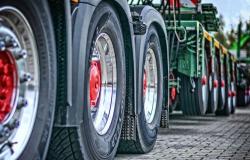Re-mobilization in Russia is not excluded
About 360,000 soldiers participated in Russia’s invasion of Ukraine on February 24, 2022. According to publicly available information, since the beginning of the invasion, Russia has lost more than 315,000 soldiers – dead or wounded. Ukrainian sources put Russian losses even higher at over 400,000 military personnel.
The significant losses of the Russian army are evidenced by the need for mobilization. To maintain the combat capabilities of the army, already in September 2022, Russian dictator Vladimir Putin signed a decree announcing partial mobilization. Soldiers were also attracted by representatives of “private” military companies fighting in Ukraine, for example, the “Wagner” group recruited soldiers in Russian prisons.
The mobilization in Russia continues in a covert manner, as this is the only way to compensate for the loss of manpower in Ukraine, SAB said. To attract new soldiers, mostly financial incentives are used, such as a salary that is higher than the Russian average. Special activities, including the involvement of law enforcement agencies, are carried out to recruit migrants living in Russia from Central Asian countries who have recently acquired Russian citizenship into the armed forces. Separate volunteer recruitment campaigns have also been observed outside of Russia in countries such as Syria, India, Cuba and Nepal, SAB noted.
As the war continues and Russia’s losses continue, repeated “open” mobilization is also not excluded, the Latvian intelligence service assessed. In announcing it, Russia’s leading elite will be guided by the situation at the front and the common mood in society.
Russia’s military-industrial complex continues to face problems
Along with the loss of soldiers, since the beginning of the war, Ukrainian forces have managed to destroy a significant amount – up to 9,000 Russian armored vehicles, including tanks, infantry fighting vehicles and other technical units, as well as aircraft and ships. The biggest losses of soldiers and equipment can be observed directly in the ground forces, while the Russian Navy and Air Force maintain relatively high combat capabilities.
As the Russian invasion of Ukraine drags on, the importance of the military-industrial complex in maintaining the combat capabilities of the Russian forces is increasing, SAB said. Russia has been able to adapt its production to the needs of the war in the short term – to ensure the repair of damaged equipment, the modernization and adjustment of spare equipment units, as well as the production of various types of ammunition, including artillery shells and rockets.
As hostilities in Ukraine continue, it is expected that Russia’s ability to renew and replenish its arsenal will decrease, SAB predicted, as sanctions are already making it difficult to access components manufactured in the West. In the production of weapons, it is necessary to use more expensive components imported into Russia through third countries, bypassing sanctions, or to rely on alternatives produced in China or other countries, which may be of lower quality or require additional adaptation, noted Latvian intelligence.
Russia’s military-industrial complex continues to face workforce problems, especially highly skilled workforce, as well as challenges to motivate employees to continue working in high-intensity conditions. The production capacity can be negatively affected by the wear and tear of the infrastructure used in production and the limited opportunities to access the components needed to restore the infrastructure’s operation, SAB said.
On the other hand, the diversion of the resources of the military-industrial complex to maintain the combat capabilities of the Russian army in Ukraine further limits the development and implementation of new military technologies, which in the medium term may increase the technological lag of Russian-made armaments compared to Western or Chinese-made armaments, SAB noted.
Russia will have difficulties in arming its forces until 2026
The war in Ukraine and the resulting geopolitical changes in Europe have made it necessary for Russia to evaluate the suitability of the existing model of the armed forces, the Latvian intelligence service noted. Already at the end of 2022, Russian Defense Minister Sergei Shoigu issued a statement on the reform of the Russian Armed Forces aimed at improving the command and control of the military forces and increasing the number of armed forces units and personnel to 1.5 million in 2026. In the western direction, as part of the reform, on February 26, 2024, the military districts of Moscow and Leningrad, which had been united in the Western military district since 2010, were restored.
Taking into account the hostilities in Ukraine and the losses of Russian soldiers and equipment, it can be predicted with high reliability that Russia will face difficulties until 2026 to make actual changes in its armed forces and to fully form and equip existing and newly created units, SAB said.
However, this will not prevent Russia from creating an image of the progress of the reform of the armed forces in its public statements. The reform process will allow Russia to maintain an aggressive position vis-à-vis NATO members bordering Russia.
The war in Ukraine has negatively affected the Russian economy and increased the defense capabilities of the West
Russia’s war in Ukraine and related sanctions have adversely affected Russia’s economy and access to foreign capital. At the same time, Russia continues to use the instruments available to the state to promote economic stability. Currently, one of the pillars of the Russian economy is its military-industrial complex, as well as the still high revenues from the international trade of hydrocarbons, including circumventing sanctions and trade restrictions.
As the war in Ukraine continues, Russia will continue to adapt its economy to the needs of the war, which on the one hand will allow the maintenance of military operations and the combat capabilities of the Russian army, but in the medium term will reduce or even stop the growth of the Russian economy, SAB concluded.
The Russian invasion of Ukraine was planned as a quick, victorious war, where Ukrainian resistance would be overcome in a short time, not a conflict lasting more than two years, for which Russia was not ready either militarily or economically. Taking into account the course of the war, Russia has to reassess the possible course of potential future conflicts and assess the country’s ability to engage in such a conflict and win, SAB said.
In invading Ukraine, the Putin regime had relied on the lack of unity in the West and the differing positions of Western countries on relations with Russia. However, the war has fostered Western unity and willingness to take steps to curb Russian aggression.
In addition, the Russian invasion has contributed to the review of the defense policy of Western countries, especially European countries, with most countries making decisions on increasing their defense capabilities in the coming years, SAB said.
One of the indicators is the diverted state funding for defense, for example, 18 of the 32 NATO member states will allocate at least 2% of their gross domestic product (GDP) to defense in 2024. According to the data of the International Institute for Strategic Studies, in 2023 the defense spending of NATO member states accounted for 57.8% of global spending, while Russia’s spending was 4.8%.
Since the beginning of the invasion of Ukraine, NATO has taken a number of important practical actions to strengthen deterrence and defense capabilities, such as the development of new regional plans. An important event in strengthening the alliance’s joint capabilities, especially in the Baltic Sea region, is the joining of Finland and Sweden to the alliance, noted Latvian intelligence.






